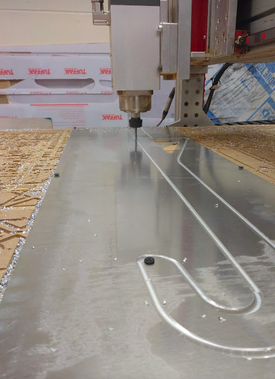 CNC router cutting out a climber 'hook' for Pyxis, 2022 CNC router cutting out a climber 'hook' for Pyxis, 2022 Computer-Aided Manufacturing, or CAM, is computer-controlled machinery integrated with software such as AutoCAD or Fusion360. The purpose of CAM is to automate the usual manufacturing process, using pre-programmed toolpaths to etch out a desired design on various raw materials– polycarb, aluminum, etc. CAM uses a sort of language converter produced from digitized data, called post-processing, that enables designs made in CAD, and then transferred to CAM, to be tangibly manufactured via a CNC machine (Computer Numerical Control). The CNC machine at Columbus Space Program’s HeadQuarters is a long metal table with a rigid arm jutting out over it, which controls the physical toolpaths. Accentured along the table are deep grooves from past cuttings and dozens upon dozens of unruly aluminum shavings to be swept up at the end of each day. Also attached to the router is a small table with the computer that inputs information taken from CAD to CAM, telling the machine its tasks. But, of course, none of this manufacturing would be able to happen without immensely focused human labor. CSP began to CNC in 2018 initially, but the bulk of the work done with it surfaced after COVID in late 2021 by our FTC team, Ecliptic. However, with no one professionally trained in operating it, the CNC router posed a huge learning curve, begging the question of whether it was worth relearning or not. Of course we can’t just waste machinery, but what also solidified the decision was the team constantly running into problems of non-precise holes and cuts. CAM and CNC would ensure custom boreholes and depressions that were near-perfect. CAM-ing and CNC-ing has undoubtedly allowed our team to test its creative limits, going beyond what was previously expected of us as well as guaranteeing more prototypes in less time. Actually, all parts now and in the future are intended to be completely CNC-ed if they are not electrically based. To make the longevity of CAM possible, we are training four rookies to be able to confidently use both the software and machinery. At all times in our history, CSP has intended to uplift innovation and independency, whether it be personal or creative expression (respectively), learning how to troubleshoot efficiently, or forming immersive and varied experiences for rookies (welding, soldering, graphic design etc.). CAM and the CNC router are each an extension of this concept, needing machinists to interpret technical drawings as well as sequence and refine software operations. CSP hopes to continue using CAM and CNC to increase the smoothness of workflow and the design-to-final-fabrication transition.
0 Comments
Leave a Reply. |
Archives
February 2024
Categories |

 RSS Feed
RSS Feed